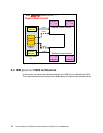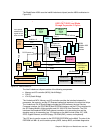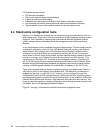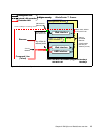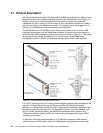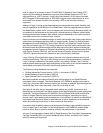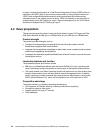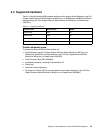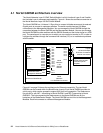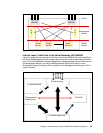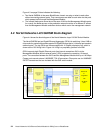Chapter 3. Nortel Networks Layer 2/3 GbE Switch Modules 17
level of support for a number of users. The IEEE 802.1D Spanning Tree Protocol (STP)
support can be enabled or disabled on a per-port basis. Multiple instances of STP are
supported (that is, 16 STP groups). Virtual Local Area Network (VLAN) support includes
802.1Q tagged VLANs and support for IEEE 802.3 support on six external ports for up to
three static trunk groups. Dynamic trunking using LACP as well as static trunking is
supported.
Adding full Layer 3 routing to the integrated switch module adds more power, flexibility, and
security capabilities to the IBM Eserver BladeCenter. With the integrated switch module in
the BladeCenter, network traffic can be managed much more efficiently. Broadcast traffic can
be contained in the blade server by placing the 14 blade servers on different subnets while
allowing communication between each without using the bandwidth of the external ports to
send traffic to and from an external Layer 3 device.
Security features provide added protection for switch configuration data, while packet filtering
helps secure and segment sensitive traffic or network access. Support for Simple Network
Management Protocol (SNMPv3), Secure Shell (SSHv2), and Hypertext Transfer Protocol
over Secure Socket Layer (HTTPS) supply protection for sensitive switch configuration data.
Multilevel access and defined access policies help secure the switch against unauthorized
management access. Support for Remote Authentication and Remote Authentication Dial-in
User Service Protocol (RADIUS), and Terminal Access Controller Access Control System
(TACACS+) gives enterprises the freedom to use current security databases.
Layer 3 filtering (IP and application type) at line rate in the chassis enhances security and
simplifies provisioning. The risk of traffic finding a route to a denied destination is reduced if
Layer 3 routing is contained in the switch module in the chassis. Without Layer 3 filtering,
several external switches might need configuration to filter traffic to limit access between one
server blade and another if the traffic flows through upstream devices.
The following routing standards are supported:
Routing Information Protocol version 1 (RIPv1), and version 2 (RIPv2)
Border Gateway Protocol version 4 (BGPv4)
Open Shortest Path First version 2 (OSPFv2)
Maximum bandwidth and network flexibility with uplink support for six Gigabit Ethernet
ports/switch (fiber or copper). The Nortel Networks L2/3 GbESM is designed to be able to
route, filter, and queue traffic so that no data is lost, dropped, or delayed. Applications get the
bandwidth they need, when they need it, with little or no delay or jitter.
Even with all the value that an integrated switch module can provide, performance for a
BladeCenter can be limited if the switch module cannot provide adequate ingress and egress
bandwidth. The Nortel Networks L2/3 GbESM is the only BladeCenter switch module that
offers six Gigabit Ethernet uplink ports for maximum throughput, supporting full Layer 2
through Layer 3 wire-speed packet forwarding for all connections. In addition, the flexibility of
both copper and fiber ports allows for optimized use in hybrid installations or for situations
where one switching infrastructure is more economical than another.
Unmatched High Availability support and field proven Resiliency High availability support is
built in at both Layer 2 and Layer 3 in the Nortel Networks L2/3 GbESM to reduce single
points of failure when it comes to enabling reliability and performance of the network.
At Layer 2 Link Aggregation Control (802.3), Rapid Spanning Tree, Fast Uplink Convergence,
Port Fast Forwarding, 802.1Q VLANs, Broadcast Storm Control, and Native Link Failover
with NIC teaming are supported.




